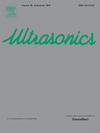Modified UNet-enhanced ultrasonic superb microvascular imaging feature extraction and grading of carpal tunnel syndrome
IF 4.1
2区 物理与天体物理
Q1 ACOUSTICS
引用次数: 0
Abstract
Carpal tunnel syndrome (CTS) is recognized as the most frequently encountered median nerve (MN) entrapment neuropathy, with a disproportionate burden in middle-aged and elderly individuals and in occupational groups with repetitive wrist use. Anatomically, CTS is characterized by compression of the median nerve within the confined space between the transverse carpal ligament and flexor tendons, and microcirculatory impairment is regarded as one of its key pathological bases. Although electrodiagnostic assessments are considered as diagnostic gold standard, their utility is limited by suboptimal patient compliance, procedural discomfort, and inadequate sensitivity for detecting mild disease. This study integrates ultrafast Superb Microvascular Imaging (SMI) with a classification-guided, improved UNet segmentation modal and quantitative image analysis to objectively extract microvascular features for CTS grading. In a cohort of 105 patients (21 mild, 71 moderate, 13 severe CTS) and 21 healthy controls, longitudinal and transverse SMI cine loops were segmented using an improved UNet with cross-plane classification guidance. The modified network can yielded superior segmentation effect over a traditional UNet. From segmented regions we extracted 6 SMI-derived geometric features, which were then used as predictors in a nonlinear quadratic regression model for CTS severity grading. The model achieved 93.7 % overall classification accuracy and an AUC of 0.95 in cross validation. Independent blind validation (n = 12) showed strong agreement with expert sonographers (Kappa = 0.87). These results demonstrate that high spatiotemporal SMI combined with anatomy-aware deep learning model could enable reproducible extraction of microvascular geometry, and supports robust, noninvasive grading of CTS, with potential for deployment on portable ultrasound platforms for point-of-care screening and bedside ultrasonic monitoring.
改良unet增强超声超细微血管成像特征提取及分级研究。
腕管综合征(Carpal tunnel syndrome, CTS)被认为是最常见的正中神经(medial nerve, MN)卡压神经病,在中老年个体和重复性手腕使用的职业人群中负担过重。在解剖学上,CTS的特点是在腕横韧带和屈肌腱之间的狭窄空间内压迫正中神经,微循环障碍被认为是其主要病理基础之一。尽管电诊断评估被认为是诊断的金标准,但由于患者依从性欠佳、程序不适以及检测轻微疾病的灵敏度不足,电诊断评估的效用受到限制。本研究将超快微血管成像技术(SMI)与分类引导、改进的UNet分割模式和定量图像分析相结合,客观提取微血管特征,用于CTS分级。在105例患者(21例轻度,71例中度,13例重度CTS)和21例健康对照中,使用改进的UNet在交叉平面分类指导下对纵向和横向SMI电影环路进行分割。改进后的网络比传统的UNet具有更好的分割效果。从分割的区域中,我们提取了6个smi衍生的几何特征,然后将其用作CTS严重程度分级的非线性二次回归模型的预测因子。在交叉验证中,该模型的总体分类准确率为93.7%,AUC为0.95。独立盲法验证(n = 12)与专家超声检查结果一致(Kappa = 0.87)。这些结果表明,高时空SMI与解剖学感知深度学习模型相结合,可以实现微血管几何形状的可重复提取,并支持稳健、无创的CTS分级,有可能部署在便携式超声平台上,用于点护理筛查和床边超声监测。
本文章由计算机程序翻译,如有差异,请以英文原文为准。
求助全文
约1分钟内获得全文
求助全文
来源期刊

Ultrasonics
医学-核医学
CiteScore
7.60
自引率
19.00%
发文量
186
审稿时长
3.9 months
期刊介绍:
Ultrasonics is the only internationally established journal which covers the entire field of ultrasound research and technology and all its many applications. Ultrasonics contains a variety of sections to keep readers fully informed and up-to-date on the whole spectrum of research and development throughout the world. Ultrasonics publishes papers of exceptional quality and of relevance to both academia and industry. Manuscripts in which ultrasonics is a central issue and not simply an incidental tool or minor issue, are welcomed.
As well as top quality original research papers and review articles by world renowned experts, Ultrasonics also regularly features short communications, a calendar of forthcoming events and special issues dedicated to topical subjects.
 求助内容:
求助内容: 应助结果提醒方式:
应助结果提醒方式:


